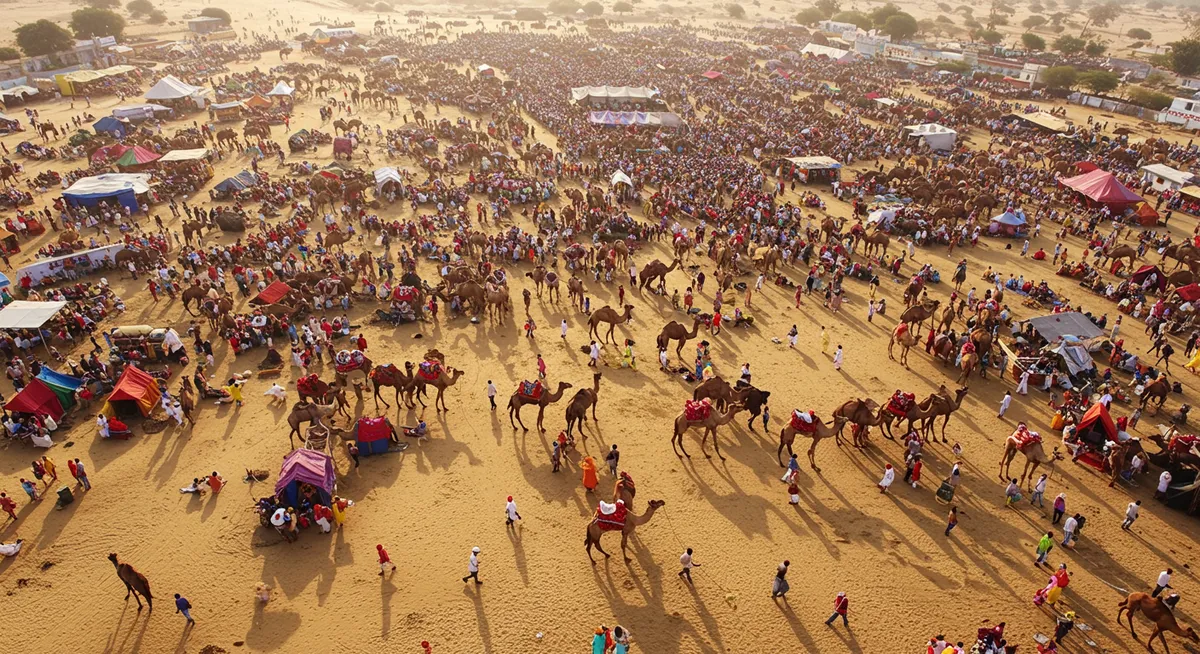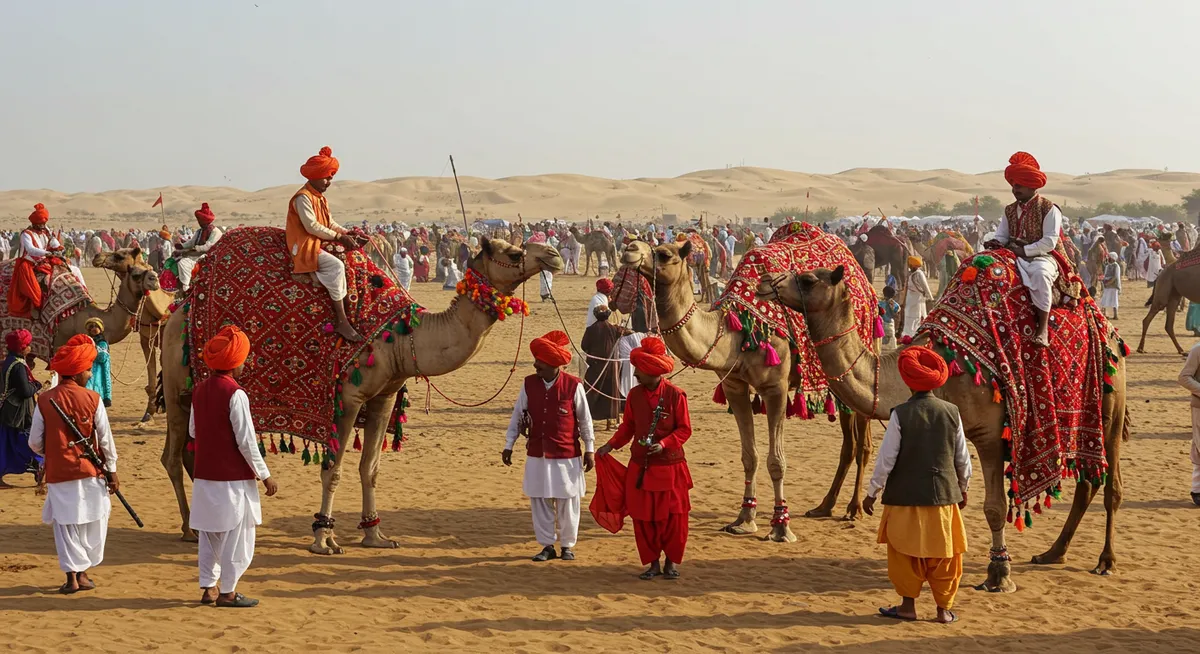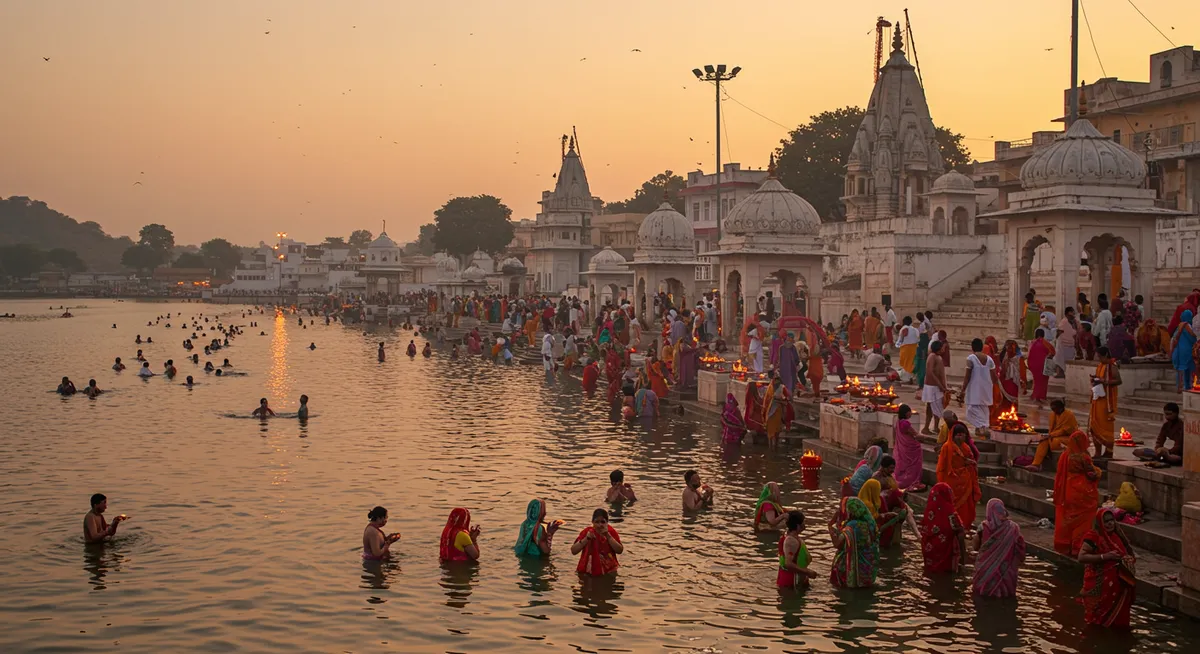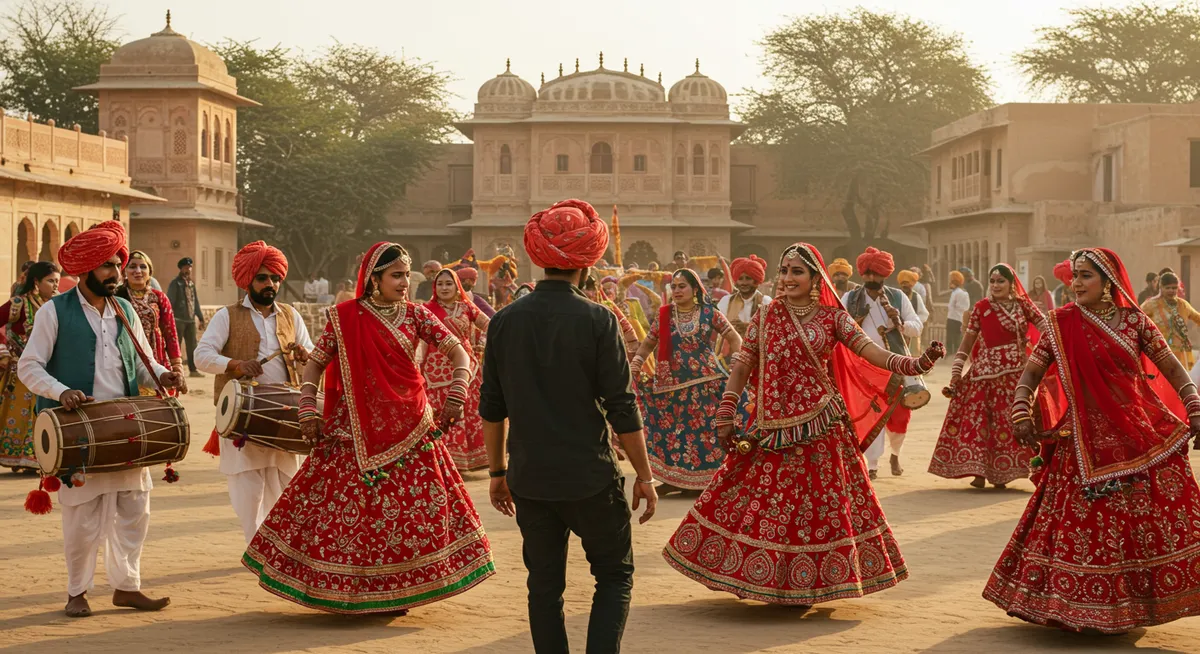Pushkar Camel Fair Guide | Rajasthan's Spectacular Desert Festival

Pushkar Camel Fair: Rajasthan's Extraordinary Desert Festival
Each November, the small sacred town of Pushkar undergoes a remarkable transformation as thousands of camels, horses, and cattle—accompanied by their elaborately turbaned traders—descend upon the golden desert sands of Rajasthan. What began centuries ago as a traditional livestock trading event has evolved into one of India's most spectacular cultural festivals, attracting traders, pilgrims, and travelers from across the globe. For approximately two weeks, the normally tranquil lakeside settlement explodes with activity as trading encampments, ritual bathers, folk performers, and curious visitors create a swirling tapestry of color and commerce against the stark desert landscape. This guide explores the fascinating cultural, commercial, and spiritual dimensions of the Pushkar Camel Fair, providing insights into experiencing this extraordinary convergence of trade, tradition, and spirituality.

The Dual Nature of Pushkar's Festival
The Pushkar Fair represents a fascinating convergence of commercial tradition and spiritual heritage:
- Livestock Trading: One of the world's largest camel and livestock fairs with centuries of commercial history
- Religious Pilgrimage: Coincides with Kartik Purnima, an auspicious full moon for Hindu bathing rituals
- Cultural Showcase: Evolved to include competitions, performances, and exhibitions of Rajasthani culture
- Tourism Destination: Now attracts visitors from around the world while maintaining authentic traditions
- Rural Economy: Critical economic event for herders, traders, and the local community
Historical Origins
While precise origins remain somewhat obscured by time, the fair's development connects several historical threads:
- Trading Traditions: Emerged from traditional livestock trading patterns among Rajasthan's rural communities
- Geographic Advantage: Pushkar's location at a desert crossroads made it a natural gathering point
- Religious Significance: Coincided with the town's sacred status as a rare Brahma temple location
- Royal Patronage: Historical support from regional rulers who recognized its commercial importance
- Evolution: Gradually expanded from purely commercial enterprise to cultural celebration
The Trading Heart of the Fair
Despite its growing cultural dimensions, livestock trading remains the fair's core purpose:
The Camel Traders
The fair attracts distinctive trading communities:
- Traditional Herding Communities: Primarily from Rajasthan, including Raika and Rebari peoples
- Multi-Generational Participation: Many families have attended for countless generations
- Distinctive Attire: Elaborate turbans, traditional dhoti garments, and ornate jewelry mark different communities
- Camp Settlements: Traders establish temporary desert camps, creating a tent city
- Social Networking: Beyond commerce, the fair enables important social connections among nomadic groups

The Art of Camel Trading
Transaction practices follow time-honored traditions:
- Price Negotiation: Elaborate verbal bargaining rituals with specific cultural protocols
- Handshake Agreements: Traditional hand-slapping gestures seal deals
- Camel Assessment: Sophisticated evaluation of animals' health, strength, and temperament
- Decorative Presentation: Camels often decorated with shaved patterns, paint, and jewelry to enhance value
- Trading Timeline: Most serious trading occurs in the days before the religious festival begins
Beyond Camels: Other Livestock
The fair encompasses diverse animal trading:
- Marwari Horses: Prized indigenous breed with distinctive inward-curving ears
- Cattle Trading: Various indigenous breeds valued for dairy and agricultural purposes
- Sheep and Goats: Smaller livestock with significant economic importance
- Animal Accessories: Market for saddles, decorative items, and specialized equipment
The Spiritual Dimension
Pushkar's profound religious significance shapes the fair's character:
Pushkar's Sacred Geography
The town holds special status in Hindu cosmology:
- Brahma's Lake: Mythology holds that the sacred lake formed where Lord Brahma dropped a lotus flower
- Rare Brahma Temple: One of very few temples worldwide dedicated to the creator deity
- Sacred Geography: The town features 52 ghats (bathing steps) and hundreds of temples
- Energy Center: Considered a spiritual power point with exceptional purifying properties
Kartik Purnima Celebrations
The culminating religious events center on the full moon:
- Ritual Bathing: Pilgrims immerse themselves in Pushkar Lake for spiritual purification
- Pre-Dawn Ceremonies: Special prayers and rituals performed at sunrise
- Temple Processions: Deities carried through town with ceremonial fanfare
- Aarti Ceremonies: Evening lamp ceremonies creating spectacular reflections on the lake
- Spiritual Merit: Belief that participating during this time brings special blessings

Spiritual Practitioners
The fair attracts diverse religious figures:
- Sadhus and Ascetics: Holy men practicing various austerities and spiritual disciplines
- Brahmin Priests: Officiating at rituals and offering blessings at the ghats
- Fortune Tellers: Traditional predictors offering spiritual guidance
- Religious Musicians: Bhajan singers and devotional performers
Cultural Attractions and Competitions
Beyond trading and religion, the fair has developed a rich program of entertainment:
Traditional Competitions
Contests showcase regional skills and traditions:
- Camel Decoration: Elaborate adornment of camels with textiles, jewelry, and body art
- Turban Tying: Competition for the most impressive traditional headwear
- Moustache Contest: Celebrating Rajasthan's famous facial hair traditions
- Matka (Water Pot) Race: Women's competition balancing clay pots
- Bridal Competition: Showcase of traditional wedding costumes and jewelry
Folk Performances
Rajasthan's rich performing arts traditions are prominently featured:
- Kalbelia Dance: Sinuous snake-inspired dance form from desert communities
- Ghoomar: Traditional women's circle dance of Rajasthan
- Kathputli Puppetry: Elaborate string puppet performances depicting folk tales
- Langas and Manganiars: Hereditary musician communities performing desert folk music
- Fire Dancing: Spectacular performances with flaming props

Modern Additions
Contemporary elements that have joined the traditional activities:
- Hot Air Balloon Rides: Offering aerial views of the spectacular landscape
- Camel Races: Organized competitions with formal race structure
- Ferris Wheel and Carnival Rides: Modern amusements alongside traditional entertainment
- Cricket Matches: Impromptu games between trader teams and visitors
- Photography Exhibitions: Showcasing the fair's visual splendor
The Artisan Marketplace
A vast temporary market showcases regional crafts and products:
- Textile Traditions: Bandhani tie-dye, block printing, and embroidered fabrics
- Rajasthani Jewelry: Silver and tribal designs with distinctive regional styles
- Leatherwork: Camel leather goods including footwear, bags, and decorative items
- Metalwork: Brass, copper, and iron crafts including bells and decorative objects
- Folk Art: Traditional paintings, pottery, and decorative items
Experiencing the Pushkar Fair as a Visitor
For travelers, the fair offers an extraordinary cultural immersion:
Practical Information
Essential planning considerations:
- Timing: Usually falls in November, based on the lunar month of Kartik (exact dates vary annually)
- Duration: Approximately two weeks, with livestock trading preceding religious ceremonies
- Peak Days: The final days culminating in Kartik Purnima see the largest crowds
- Weather: Generally pleasant daytime temperatures (20-25°C/68-77°F) but cold desert nights
- Entry Fees: Some viewing areas and cultural programs may require tickets
Accommodation Options
Where to stay during this high-demand period:
- Luxury Tented Camps: Temporary but well-appointed desert accommodations set up specifically for the fair
- Pushkar Hotels: Limited permanent options that book months in advance
- Ajmer Accommodations: More options in the nearby larger city (11km away)
- Homestays: Local family accommodations offering cultural immersion
- Advance Booking: Reservations 6-12 months ahead strongly recommended
Navigation and Transport
Getting around during the busy fair period:
- Reaching Pushkar: Nearest airport at Jaipur (150km), with train service to Ajmer (11km)
- Local Transport: Auto rickshaws, camel carts, and taxis connect fair areas
- Fair Layout: Trading grounds outside town, with cultural events centered near the lake
- Walking Considerations: Substantial distances in dusty conditions between sites
- Guided Options: Local guides help navigate the complex cultural landscape
Cultural Etiquette
Respectful participation enhances the experience:
- Modest Dress: Conservative clothing recommended, particularly near religious sites
- Photography Consideration: Ask permission before photographing individuals, especially women and sadhus
- Sacred Lake Respect: Observe specific protocols at ghats; non-Hindus may not enter water at some locations
- Ritual Participation: Some ceremonies welcome visitors, while others are restricted
- Negotiation Norms: Bargaining expected in markets but with respectful approach
Health and Comfort
Preparing for desert conditions:
- Sun Protection: Hat, sunscreen, and sunglasses essential in the open desert
- Dust Management: Scarf or mask helpful for dusty conditions
- Hydration: Bottled water crucial in the dry climate
- Footwear: Comfortable closed shoes for sandy, uneven terrain
- Temperature Adaptation: Layers for significant day-to-night temperature variations
Beyond the Fair: Exploring Pushkar
The town itself offers numerous attractions:
- Brahma Temple: The rare temple dedicated to the creator deity
- Savitri Temple: Hilltop shrine requiring a challenging hike but offering panoramic views
- Pushkar Lake Circuit: Walking route around the sacred lake with 52 bathing ghats
- Old Rangnath Temple: Ancient Vishnu temple with distinctive architecture
- Camel Safaris: Desert excursions available before and after the fair
Planning your Pushkar Fair experience?
The Pushkar Fair typically takes place in November, with dates varying each year based on the lunar calendar. Check the exact dates for your travel year as they shift annually.
For the most comprehensive experience, plan to arrive a few days before Kartik Purnima to witness the active livestock trading, then stay through the full moon for the spiritual ceremonies and cultural performances.
Explore Related Asian Cultural Festivals
If you're fascinated by the Pushkar Camel Fair, discover these other remarkable cultural celebrations across Asia:
Naadam Festival
Mongolia's celebration of nomadic culture featuring traditional wrestling, archery, and horse racing.
Hornbill Festival
India's "Festival of Festivals" showcasing the cultural heritage of Nagaland's diverse tribes.
Esala Perahera
Sri Lanka's grand procession featuring decorated elephants, traditional dancers, and ancient rituals.
Holi Festival
India's vibrant spring celebration with colorful powder and joyous community traditions.
Harbin Ice Festival
China's spectacular winter celebration featuring enormous illuminated ice architecture.
Diwali
India's festival of lights celebrating the triumph of light over darkness with oil lamps and fireworks.
Explore how different Asian cultures celebrate their heritage through festivals. While the Pushkar Fair showcases Rajasthan's desert traditions, Mongolia's Naadam celebrates the skills of the steppes, and Nagaland's Hornbill Festival preserves tribal heritage. Each celebration offers unique insights into Asia's extraordinary cultural diversity.